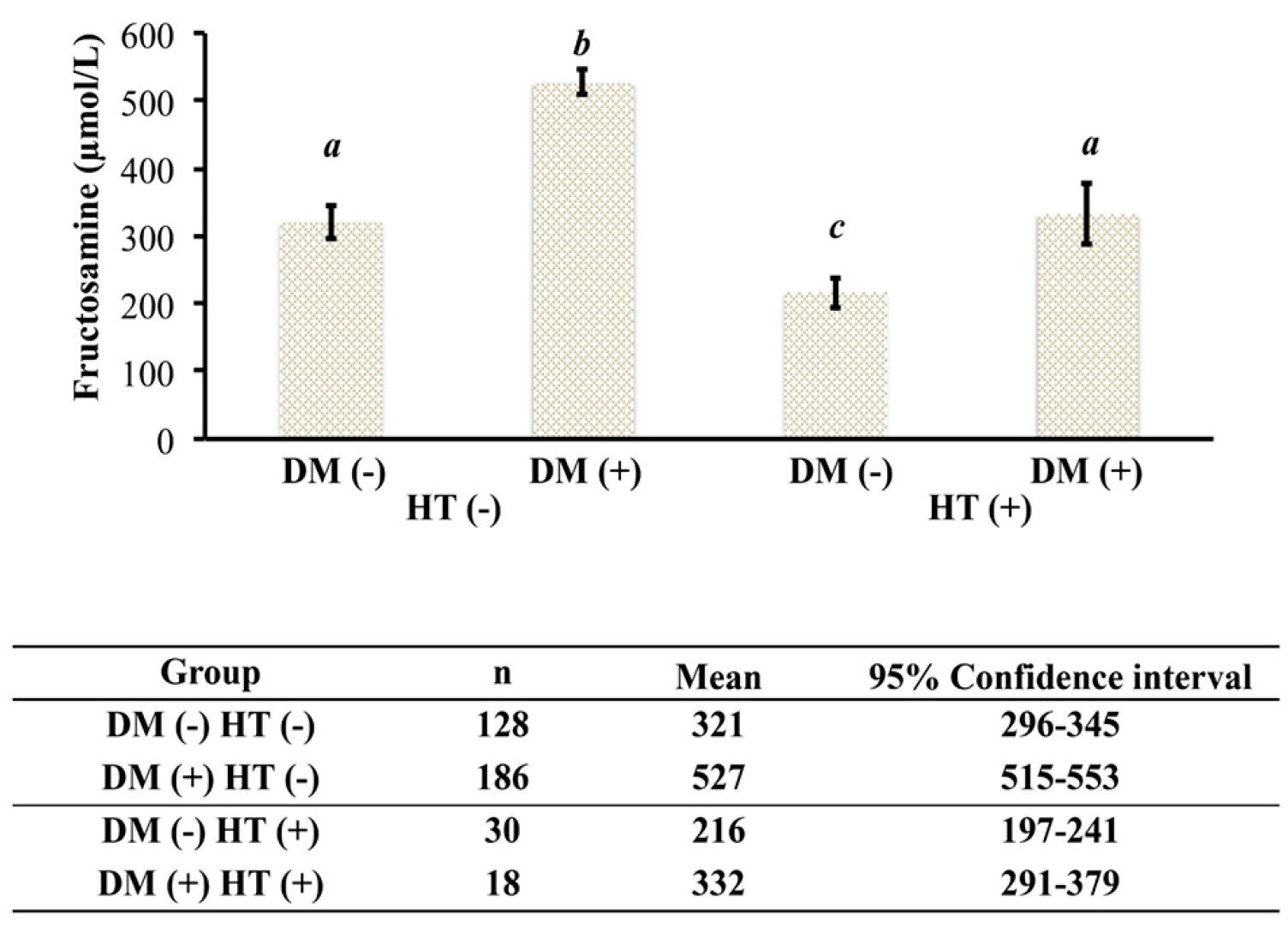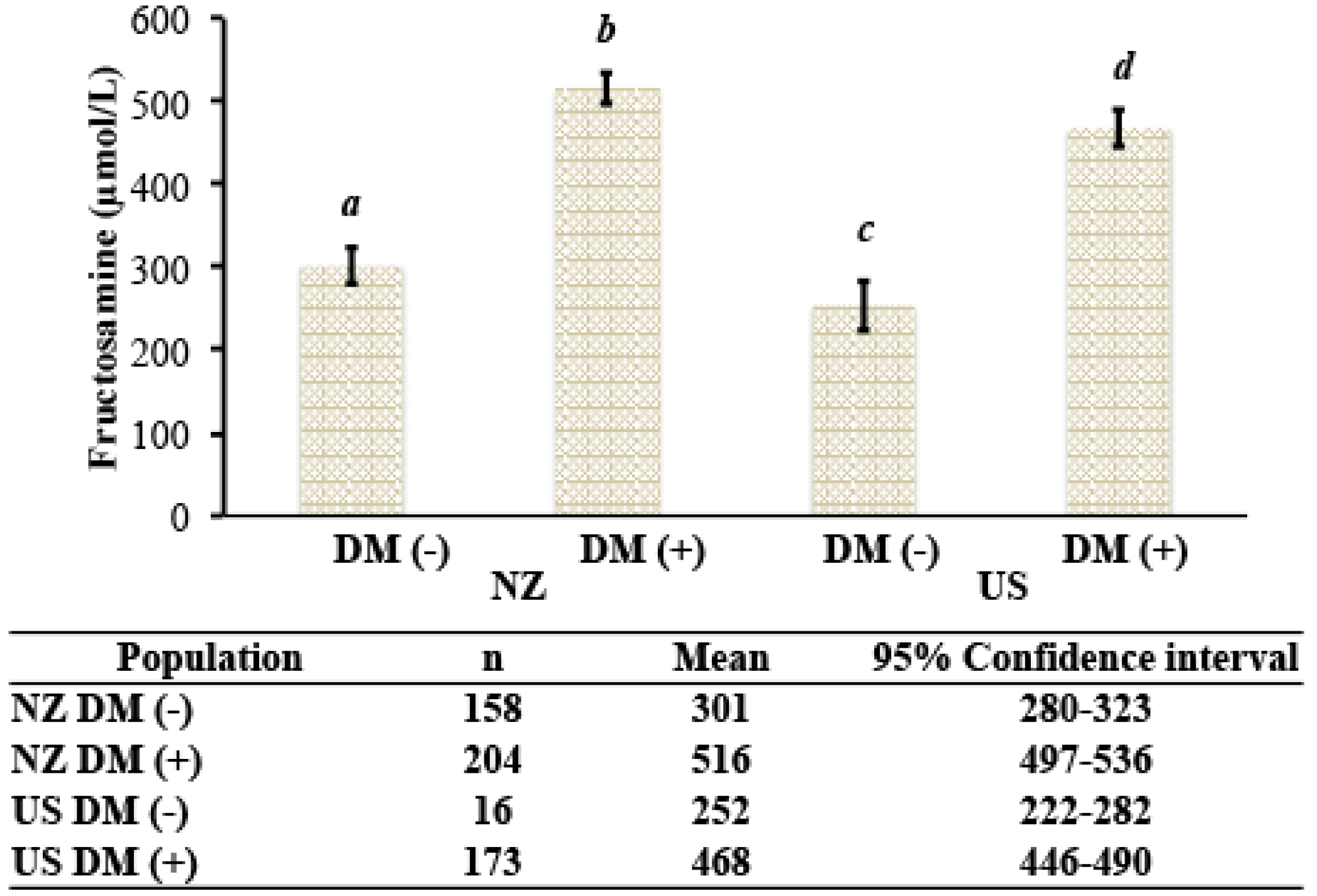Serum Fructosamine Concentration in Uncontrolled Hyperthyroid Diabetic Cats Is within the Population Reference Interval
Abstract
:1. Introduction
2. Materials and Methods
2.1. Databases
2.2. Statistical Analysis
3. Results
4. Discussion
5. Conclusions
Acknowledgments
Author Contributions
Conflicts of Interest
References
- O’Neill, D.G.; Gostelow, R.; Orme, C.; Church, D.B.; Niessen, S.J.; Verheyen, K.; Brodbelt, D.C. Epidemiology of diabetes mellitus among 193,435 cats attending primary-care veterinary practices in England. J. Vet. Intern. Med. 2016, 30, 964–972. [Google Scholar] [CrossRef] [PubMed]
- Gilor, C.; Niessen, S.J.; Furrow, E.; DiBartola, S.P. What’s in a name? Classification of diabetes mellitus in veterinary medicine and why it matters. J. Vet. Intern. Med. 2016, 30, 927–940. [Google Scholar] [CrossRef] [PubMed]
- Rand, J.S.; Kinnaird, E.; Baglioni, A.; Blackshaw, J.; Priest, J. Acute stress hyperglycemia in cats is associated with struggling and increased concentrations of lactate and norepinephrine. J. Vet. Intern. Med. 2002, 16, 123–132. [Google Scholar] [CrossRef] [PubMed]
- Laluha, P.; Gerber, B.; Laluhova, D.; Boretti, F.S.; Reusch, C.E. Stress hyperglycemia in sick cats: A retrospective study over 4 years. Schweiz. Arch. Tierheilkd. 2004, 146, 375–383. [Google Scholar] [CrossRef] [PubMed]
- Crenshaw, K.L.; Peterson, M.E.; Heeb, L.A.; Moroff, S.D.; Nichols, R. Serum fructosamine concentration as an index of glycemia in cats with diabetes mellitus and stress hyperglycemia. J. Vet. Intern. Med. 1996, 10, 360–364. [Google Scholar] [CrossRef] [PubMed]
- Elliott, D.A.; Nelson, R.W.; Reusch, C.E.; Feldman, E.C.; Neal, L.A. Comparison of serum fructosamine and blood glycosylated hemoglobin concentrations for assessment of glycemic control in cats with diabetes mellitus. J. Am. Vet. Med. Assoc. 1999, 214, 1794–1798. [Google Scholar] [PubMed]
- Kaneko, J.J.; Kawamoto, M.; Heusner, A.A.; Feldman, E.C.; Koizumi, I. Evaluation of serum fructosamine concentration as an index of blood glucose control in cats with diabetes mellitus. Am. J. Vet. Res. 1992, 53, 1797–1801. [Google Scholar] [PubMed]
- Thoresen, S.I.; Bredal, W.P. Clinical usefulness of fructosamine measurements in diagnosing and monitoring feline diabetes mellitus. J. Small Anim. Pract. 1996, 37, 64–68. [Google Scholar] [CrossRef] [PubMed]
- Gilor, C.; Graves, T.K.; Lascelles, B.D.; Thomson, A.E.; Simpson, W.; Halpern, D.S. The effects of body weight, body condition score, sex, and age on serum fructosamine concentrations in clinically healthy cats. Vet. Clin. Pathol. 2010, 39, 322–328. [Google Scholar] [CrossRef] [PubMed]
- Graham, P.A.; Mooney, C.T.; Murray, M. Serum fructosamine concentrations in hyperthyroid cats. Res. Vet. Sci. 1999, 67, 171–175. [Google Scholar] [CrossRef] [PubMed]
- Reusch, C.E.; Haberer, B. Evaluation of fructosamine in dogs and cats with hypo- or hyperproteinaemia, azotaemia, hyperlipidaemia and hyperbilirubinaemia. Vet. Rec. 2001, 148, 370–376. [Google Scholar] [CrossRef] [PubMed]
- Baral, R.; Peterson, M.E. Thyroid gland disorders. In The Cat: Clinical Medicine and Management; Little, S.E., Ed.; Elsevier Saunders: Philadelphia, PA, USA, 2012; pp. 571–592. [Google Scholar]
- De Wet, C.S.; Mooney, C.T.; Thompson, P.N.; Schoeman, J.P. Prevalence of and risk factors for feline hyperthyroidism in Hong Kong. J. Feline Med. Surg. 2009, 11, 315–321. [Google Scholar] [CrossRef] [PubMed]
- Mooney, C.T.; Peterson, M.E. Feline hyperthyroidism. In Manual of Canine and Feline Endocrinology, 4th ed.; Mooney, C.T., Peterson, M.E., Eds.; British Small Animal Veterinary Association: Gloucester, UK, 2012; pp. 199–203. [Google Scholar]
- Sassnau, R. Pidemiological investigation on the prevalence of feline hyperthyroidism in an urban population in Germany. Tierarztl. Prax. 2006, 34, 450–457. [Google Scholar]
- Stephens, M.J.; O’Neill, D.G.; Church, D.B.; McGreevy, P.D.; Thomson, P.C.; Brodbelt, D.C. Feline hyperthyroidism reported in primary-care veterinary practices in England: Prevalence, associated factors and spatial distribution. Vet. Rec. 2014, 175. [Google Scholar] [CrossRef] [PubMed]
- Crenshaw, K.L.; Peterson, M.E. Pretreatment clinical and laboratory evaluation of cats with diabetes mellitus: 104 Cases (1992–1994). J. Am. Vet. Med. Assoc. 1996, 209, 943–949. [Google Scholar] [PubMed]
- Schaefer, S.; Kooistra, H.S.; Riond, B.; Suchodolski, J.S.; Steiner, J.M.; Prins, M.; Zini, E.; Reusch, C.E. Evaluation of insulin-like growth factor-1, total thyroxine, feline pancreas-specific lipase and urinary corticoid-to-creatinine ratio in cats with diabetes mellitus in Switzerland and The Netherlands. J. Feline Med. Surg. 2016. [Google Scholar] [CrossRef] [PubMed]
- Reusch, C.E. Feline diabetes mellitus. In Canine and Feline Endocrinology, 4th ed.; Feldman, E.C., Nelson, R.W., Reusch, C.E., Scott-Moncrieff, J.C.R., Behrend, E.N., Eds.; Elsevier: St. Louis, MO, USA, 2015; pp. 258–314. [Google Scholar]
- Sieber-Ruckstuhl, N.S.; Kley, S.; Tschuor, F.; Zini, E.; Ohlerth, S.; Boretti, F.S.; Reusch, C.E. Remission of diabetes mellitus in cats with diabetic ketoacidosis. J. Vet. Intern. Med. 2008, 22, 1326–1332. [Google Scholar] [CrossRef] [PubMed] [Green Version]
- Sparkes, A.H.; Cannon, M.; Church, D.; Fleeman, L.; Harvey, A.; Hoenig, M.; Peterson, M.E.; Reusch, C.E.; Taylor, S.; Rosenberg, D.; et al. ISFM consensus guidelines on the practical management of diabetes mellitus in cats. J. Feline Med. Surg. 2015, 17, 235–250. [Google Scholar] [CrossRef] [PubMed]
- Rochon, C.; Tauveron, I.; Dejax, C.; Benoit, P.; Capitan, P.; Fabricio, A.; Berry, C.; Champredon, C.; Thieblot, P.; Grizard, J. Response of glucose disposal to hyperinsulinaemia in human hypothyroidism and hyperthyroidism. Clin. Sci. (Lond) 2003, 104, 7–15. [Google Scholar] [CrossRef] [PubMed]
- Feldman, E.C.; Nelson, R.W. Feline hyperthyroidism (thyrotoxicosis). In Canine and Feline Endocrinology and Reproduction, 2nd ed.; W.B. Saunders: Philadelphia, PA, USA, 1996; pp. 118–165. [Google Scholar]
- Mitrou, P.; Raptis, S.A.; Dimitriadis, G. Insulin action in hyperthyroidism: A focus on muscle and adipose tissue. Endocr. Rev. 2010, 31, 663–679. [Google Scholar] [CrossRef] [PubMed]
- Scott Moncrieff, J.C.R. Feline hyperthyroidism. In Canine and Feline Endocrinology, 4th ed.; Feldman, E.C., Nelson, R.W., Reusch, C.E., Scott-Moncrieff, J.C.R., Behrend, E.N., Eds.; Elsevier: St. Louis, MO, USA, 2015; pp. 136–195. [Google Scholar]
- Graves, T.K.; Peterson, M.E. Diagnosis of occult hyperthyroidism in cats. Probl. Vet. Med. 1990, 2, 683–692. [Google Scholar] [PubMed]
- Link, K.R.; Rand, J.S. Changes in blood glucose concentration are associated with relatively rapid changes in circulating fructosamine concentrations in cats. J. Feline Med. Surg. 2008, 10, 583–592. [Google Scholar] [CrossRef] [PubMed]




| Parameter | NZVP | CSU-VTH |
|---|---|---|
| n | 659 | 189 |
| Age (years; mean ± SD; min–max) | 11 ± 4; 1–24 | 13 ± 5; 1–26 |
| Males | 281 | 61 |
| Females | 343 | 126 |
| Unknown sex | 35 | 2 |
| Fructosamine (mean ± SD) µmol/L | 384 ± 182 (n = 659) | 449 ± 154 (n = 187) |
| TT4 (mean ± SD) nmol/L | 31 ± 33 (n = 659) | N/A |
| Glucose (mean ± SD) mmol/L | 16.8 ± 7.9 (n = 297) | N/A |
| Domestic Shorthair | 416 | 131 |
| Domestic Longhair | 66 | 41 |
| Burmese | 45 | 0 |
| Domestic Mediumhair | 18 | 0 |
| Birman | 8 | 0 |
| Siamese | 6 | 8 |
| Ragdoll | 4 | 0 |
| Abyssinian | 3 | 1 |
| Tonkinese | 3 | 0 |
| Maine Coon | 2 | 2 |
| Russian Blue | 2 | 0 |
| Persian cross | 2 | 0 |
| Balinese | 1 | 0 |
| Birman | 1 | 0 |
| British | 1 | 0 |
| British Blue | 1 | 0 |
| Burmese cross | 1 | 0 |
| Chinchilla | 1 | 0 |
| Cornish Rex | 1 | 0 |
| Manx | 1 | 0 |
| Ocicat | 1 | 0 |
| Oriental cross | 1 | 1 |
| Persian | 1 | 0 |
| Ragdoll cross | 1 | 0 |
| Siamese cross | 1 | 0 |
| Somali | 1 | 0 |
| Sphinx | 1 | 0 |
| Himalayan | 0 | 1 |
| unknown | 69 | 4 |
| Parameter | Effect (%) |
|---|---|
| Age | 3.13 |
| Sex | 0.00 |
| Population | 1.81 |
| Diabetes | 49.65 |
| Residual | 45.40 |
© 2017 by the authors. Licensee MDPI, Basel, Switzerland. This article is an open access article distributed under the terms and conditions of the Creative Commons Attribution (CC BY) license ( http://creativecommons.org/licenses/by/4.0/).
Share and Cite
Gal, A.; Trusiano, B.; French, A.F.; Lopez-Villalobos, N.; MacNeill, A.L. Serum Fructosamine Concentration in Uncontrolled Hyperthyroid Diabetic Cats Is within the Population Reference Interval. Vet. Sci. 2017, 4, 17. https://doi.org/10.3390/vetsci4010017
Gal A, Trusiano B, French AF, Lopez-Villalobos N, MacNeill AL. Serum Fructosamine Concentration in Uncontrolled Hyperthyroid Diabetic Cats Is within the Population Reference Interval. Veterinary Sciences. 2017; 4(1):17. https://doi.org/10.3390/vetsci4010017
Chicago/Turabian StyleGal, Arnon, Brie Trusiano, Adrienne F. French, Nicolas Lopez-Villalobos, and Amy L. MacNeill. 2017. "Serum Fructosamine Concentration in Uncontrolled Hyperthyroid Diabetic Cats Is within the Population Reference Interval" Veterinary Sciences 4, no. 1: 17. https://doi.org/10.3390/vetsci4010017






